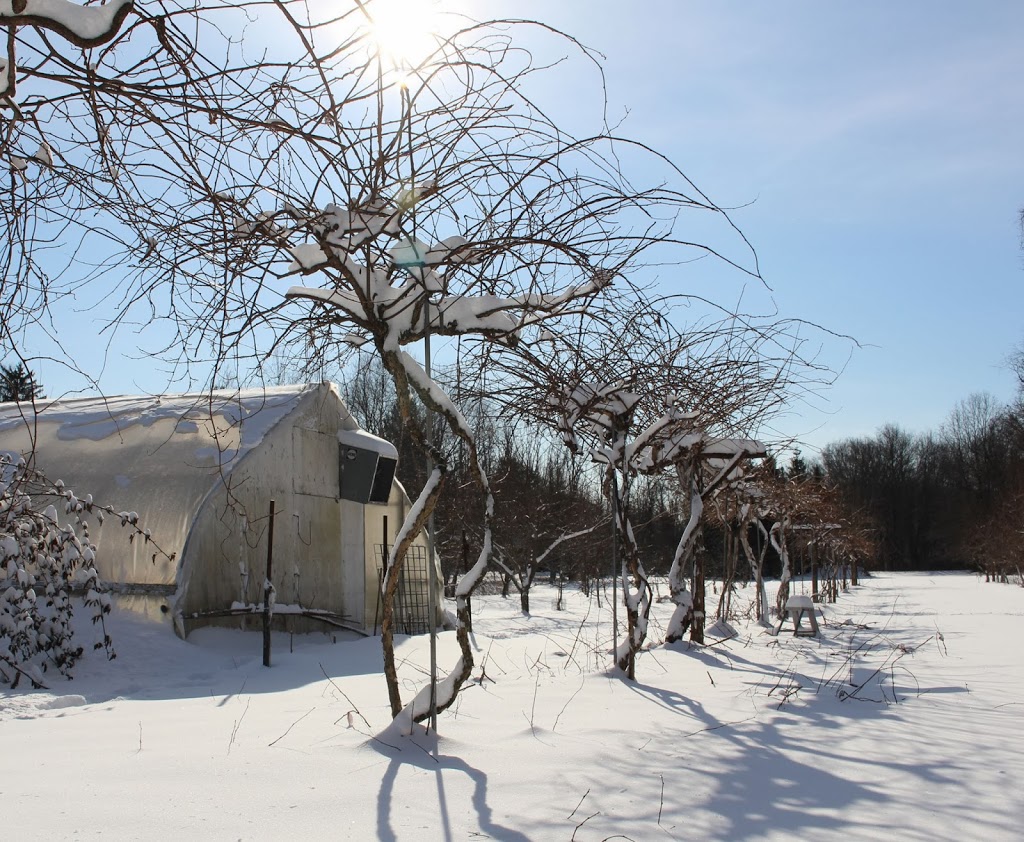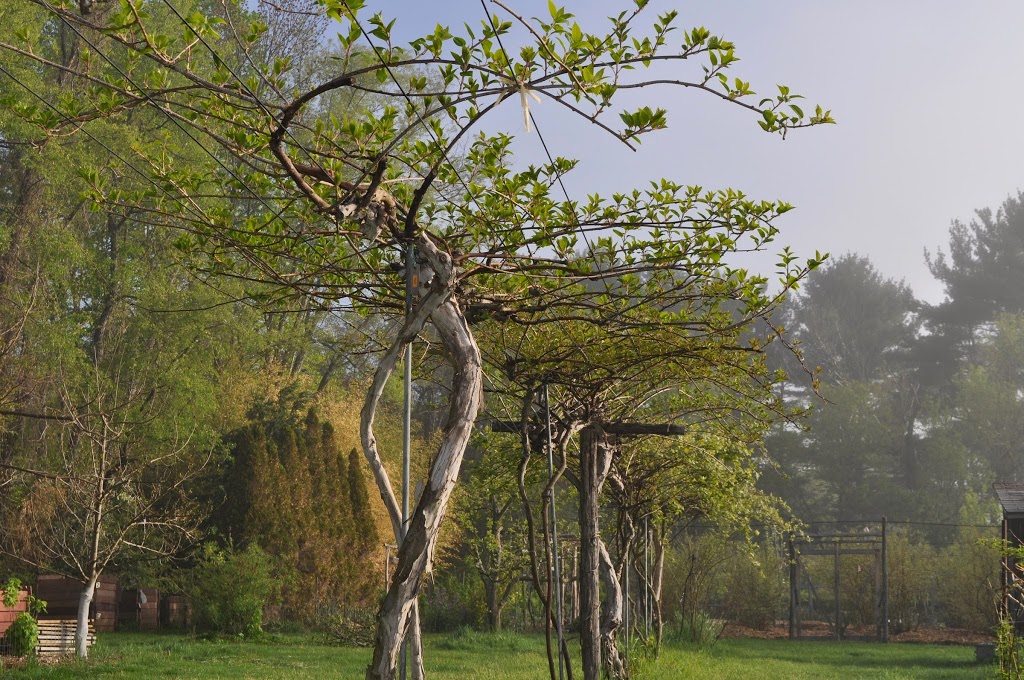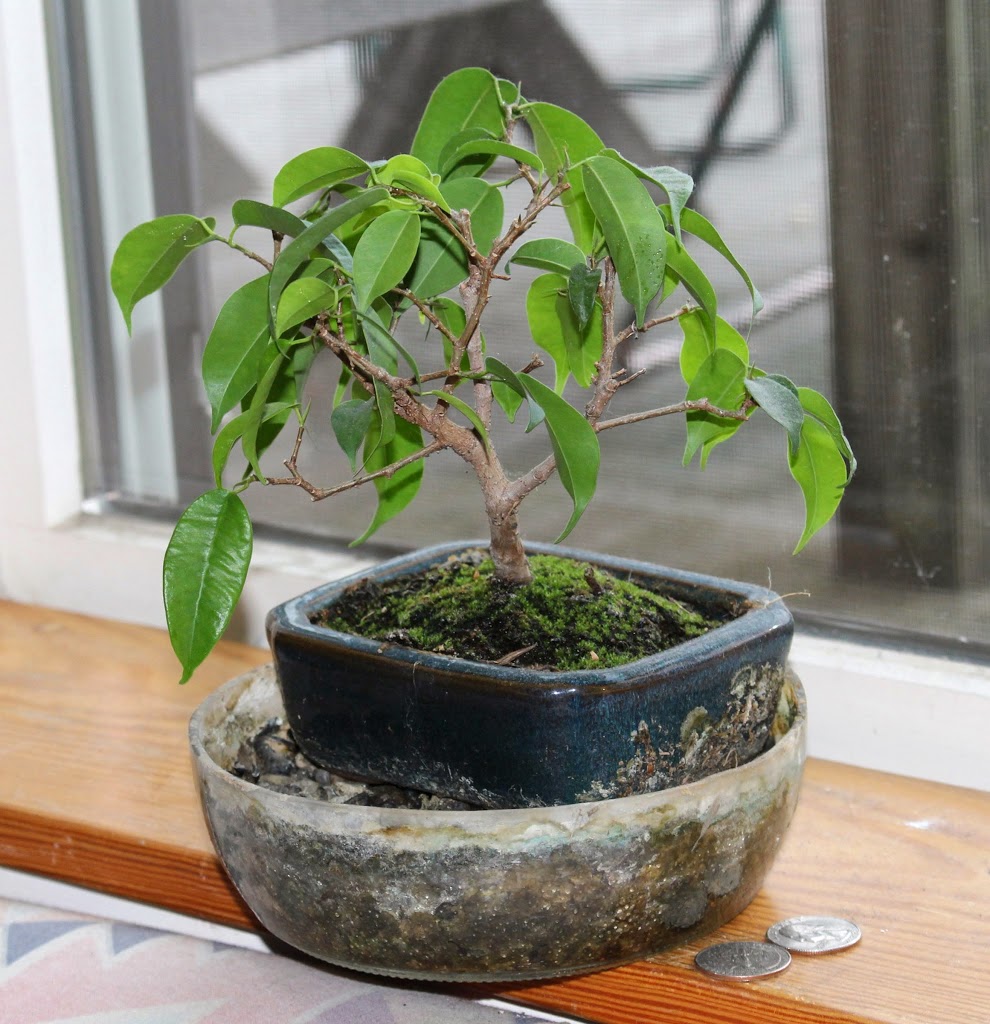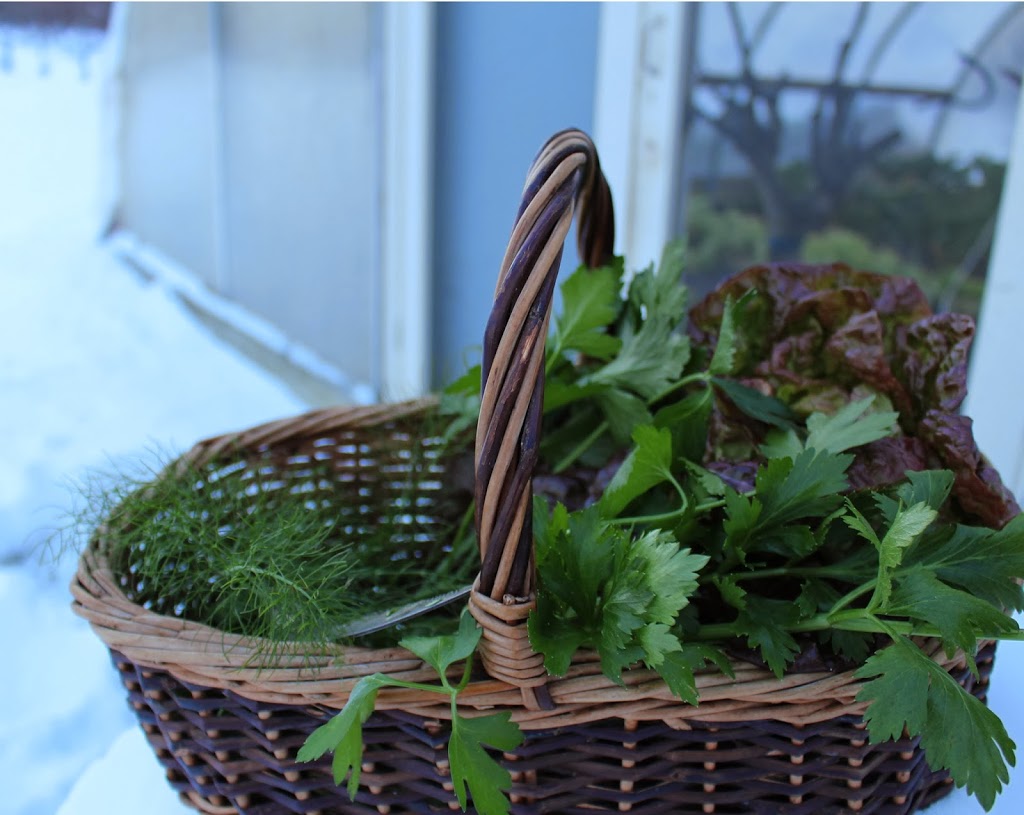Last week I wrote that, what with the cold weather and low-hanging sun showing its face but briefly each day, there’s little for a gardener to do now. That proved not strictly true. Soon after I wrote those words, I received a holiday card from David Jackson and Holly Laubach of Kiwi Berry Organics, growers of what I can attest to are, as it said on the card, the “World’s Sweetest Kiwi.” Theirs are hardy kiwifruits, the small, cold-hardy cousins of the fuzzy kiwis you usually see in the market; with their smooth skins, you pop them into your mouth like grapes.
Most importantly, David and Holly’s card sported a photo, a snowy scene of their kiwi plants pruned to perfection, the fruiting canes all neatly arching over with their ends tied down to their supporting wires. To
 |
| David and Holly’s kiwis |
me, the scene was both beautiful and inspirational. Acting on inspiration, I headed outdoors, pruners in hand, to get to work on my own kiwi vines.
In past years, I delayed all pruning until after the coldest part of winter. Accepted wisdom is that later pruning reduces chances for winter injury. Last year, David told me he started pruning his vines in autumn after leaves dropped. I followed suit warily with one or two vines and they came through winter unscathed. Perhaps it’s our warmer winters of late, perhaps damage that occurs depends on the plant species, or perhaps the accepted wisdom is wrong. At any rate, I’m now pruning with abandon.
————————————————————–
Staring at the tangle of stems on my kiwi plants could have quelled my enthusiasm had I not been presented with this sight in years past. Kiwis are rampant vines, each year sending out masses of vigorous (as long as 15 feet!) that twisting stems that are hard, at first, to make sense out of. Pruning is a must to
 |
| My kiwis, before pruning |
keep the vines manageable and easy to harvest, bathed in sunlight for high quality fruit, and to stimulate an annual flush of new wood. Fruits are borne only near the bases of new shoots growing off one-year-old canes.
My plants, like David’s, are trained on a T-trellis about 6 feet high with 5 parallel wires running from T to T. Each trunk rises to the height of the T and then has been trained to spread into two permanent arms, one growing in either direction along the middle wire. The one-year-old canes, off which fruit is borne, grow perpendicularly to the permanent arms, their ends tied down to the two outermost wires.
————————————————————-
My pruning begins with three easy steps. I cut away any shoots poking up from ground level or out along the trunks below the level of the wires. I shorten all fruiting canes a foot or so beyond the outside wires. And I cut the permanent arms back to where they began growth so that adjacent vines don’t grow into each other.
Then things get more complicated. Too many fruiting canes sprout each year from the permanent arms
 |
My kiwis, last spring, after pruning
(except final shortening) |
and from along canes that were left for last year’s fruits. The goal is to remove enough so that those that remain are spaced a foot apart on either side of the permanent arms, favoring those that are pencil-thick and originating either from the permanent arm or near the base of a last or previous year’s cane.
Finally, pruning becomes easy again. All remaining fruiting canes get shortened to 2 feet long and then tied them down to the wires, hopefully as neatly as on Dave’s and Holly’s vines. I will delay these last steps until later in spring.
————————————————————–
I realize that not many people grow hardy kiwi vines. You all should: The vines are ornamental (they were brought here and for decades grown strictly as ornamental vines), and the fruits are
delectable and free of pest problems. Even if you don’t grow hardy kiwi vines, though, the above pruning technique could be useful to you. It can be applied, with slight modification, to grapes, which a lot of people do grow.
The only differences with pruning grapes is that the fruiting arms can be spaced somewhat closer along the permanent arm, 6 to 12 inches apart, and each fruiting arm needs to be shortened to only a couple of buds long, at which point they take on a new name, “fruiting spurs” rather than “fruiting arms.”
Whether for grapes or for hardy kiwi vines, training to a T trellis and annual pruning presents me, in late summer on into fall, with “ceilings” of delicious berries splayed out and ready for easy harvest.








Excellent post, I never seen a kiwi before, but as you mentioned here, it is a vine kind of plant. Indeed, Kiwi fruits are nutritious and can be added to salads or even eaten alone as fruit.
I just planted a very young kiwi vine and hadn’t planned on pruning – thanks for these tips. It is not on a T-system but will grow along the trellised wall of my front porch. I will train along this “wall” with the steps you describe – thank you. I can’t wait to try the fruit!
Kiwifruits is my favorite. It is not only delicious, it also has lots of benefits when it comes to our health.
I was wondering if you could trellis raspberry bushes under the kiwi using the same support posts? I’ve never grown either and would like your thoughts. Great post!
Interesting idea with two potential problems. One is that it would make it hard to get at the kiwis to prune and harvest — and the kiwis need multiple prunings each year. And second, the shade would limit raspberry production and make it easier for fungal disease to take hold.
Do you get late spring frosts? If so, how do you deal with them? It’s late April and we are expecting a freeze tomorrow (zone 5b/6a, btw). I have wanted to grow kiwis for years but the more research I do, the more I read how early blooming and how frost sensitive they are. I’m thinking on passing on kiwis but I’d love to try it if you have a trick.
Yes, I get spring frosts. The way I deal with them is, unscientifically, by keeping my fingers crossed. But seriously, whether damage occurs depends on the severity of the frost, the stage of plant growth, and, perhaps, the age of the plants. A light frost usually does little or no harm. New sprouts often develop if older ones have been nipped. Plants seem to tolerate frosts better with age, which could be a microclimate effect as canopy develops.
Please tell me the names of your kiwi plants. I live in NC and would like to plant a few kiwi plants that someone can tell me are really sweet and worth the time to build a trellis for and tend to. Thank you so much.
All the hardy kiwis are worth the effort. Among Actinidia arguta, I’d recommend Geneva and Dumbarton. Any of the A. kolomikta varieties seem good. See my book Uncommon Fruits for Every Garden for more about these wonderful plants.
Dr.
Reich I have hayward females and Chico male vine, they are about 4 days out of synch in flowering. With my grape vineyard I can delay/advance vine growth by managing pruning time. Have you heard of the pruning time on kiwis giving us a way to delay/speed up the flowing schedule? desperate ken
I think the pruning used to delay/advance grapes would also work for kiwis (or, probably, and other plant). Would that be pruning later in the dormant season to delay growth? I would have thought the kiwi bloom times long enough so that there would be sufficient overlap even if 4 days out of sync.
I inherited several kiwi vines that had been recently planted when we purchased this house. We have several acres but these were planted along the side of the house. They were never trellised. I am trying to decide if I should move them so I can trellis them on old clothesline poles or put lattice behind them and leave them where they are. The biggest issue here is wind. Against the side of the house they are maybe a little protected, but on the old clothesline they will be out in the open. In the landscaping where they currently are is very fertile soil, whereas the clothesline posts are is Indiana clay (fertile enough for my neighbor to plant her garden in but I’m not sure if it’s fertile enough for these plants). Anyway, I thought I would ask your thoughts since from your photo I’m wondering where you have planted yours in terms of the impact of the wind. Out here there are few trees so the wind just whips across this acreage. Thanks for your input.
Too close to a house makes kiwi vines very hard to prune and pick. Especially if they are Actinidia arguta, they’ll take over everything unless rigorously pruned. I’d plant them on a STURDY trellis away from the house.Kiwis do not need very fertile soil, just very good drainage.
Hi we have a fuzzy kiwi vine that we inherited when buying our house in France. Initially we got lots of fruit until it was cut back vigorously by a friend in the summer when fruits were on the vines. Since then for the last 2 years we have had no fruit or flowers but the vines still grow very big. Any ideas? thank you for any inpur
You have to let stems get mature enough to fruit again. The short answer is, when pruning, to totally remove some shoots. But leave some shoots full length. I go into pruning kiwis in more detail in my book THE PRUNING BOOK.
Last year I purchased 2 female and one male hardy kiwis (Anna and kens red). They arrived looking very healthy and I planted them in the same manner I have all my other bare root fruits. They put out nice new growth but after a few weeks that growth slowly turned black and died. The plants proceeded to put out more growth a few more times but each time the same thing happened. Then they stopped putting out any new growth and died. This year I replaced them and decided to baby them. They have received every nicety a plant could want: large pots, good soil, plenty of water, sunshine, and protection from cold. Lo and behold they are doing the same thing! Too much intense sunshine (7000 ft elevation) was my guess but they didn’t perk up with shade. Any ideas what my problem might be? Thank you!
Too much water?
Hello Dr. Reich,
I am very interested in starting hardy kiwi plants in pots on our terrace with full sun. Living in the Bronx, NY, I am interested in purchasing mature kiwi plants that would be ready to bear fruit the year I buy them. Would that be possible? Do local NY nurseries, maybe going north to pick one up, sell mature kiwi -could be red ken, buying male and female , or Issai. Or for all of them, is it best to wait 1-2 years?
I am reading and enjoying The Pruning Book.
Better to get a younger one and wait. For your situation, purchase mail and female plants of Actinidia kolomikta. They are more restrained in the growth and bear quicker than the other major fruiting species. I would not buy either Ken’s Red (not kolomikta) or Issai.
Why don’t you recommend the Ken’s Red variety?
Mine, after many years, never bore any fruit. I’ve never tasted it. I suspect that, since the fruits are red, birds would go for it.
This blog post is invaluable! I have had hardy kiwis in Michigan (zone 6b) for 7 Years and this year was the first time that they fruited. Just 3 little fruits on such a gigantic, robust set of plants. Now that I know your book exists, I will be purchasing it ASAP.
Thanks.
I have 1 yellow kiwi and 1 green kiwi. can they pollinate and produce fruit
They can if they blossom at the same time, ir if you collect and save pollen from the earlier one to dust on female flowers.
Lee,
What size pipe are you using for the trellis upright and cross bar? i have the ability to weld, and wanted something longer lasting than some treated wood.
Did you drill holes through the pipe for the wires to run through?
Thanks for the time and the blog.
Jordan
I’m emailing you close up photos of the arbor trellis. The upright pipe is about 1.5″ diameter and the angle iron looks like 2 x 2. There’s a notch for the wires. On the end posts the notches are keyholed to accommodate the cam mechanism through which the wire is pulled to make it taut. My wire isn’t actually wire, but nylon monofilament. You might want to put something in the middle posts to prevent excessive abrasion of the nylon wire, if you use it. My middle posts are of wood but I might switch them over to iron if it’s not too expensive. (I don’t weld.) Read up about the nylon monofilament if you use it; it differs in many ways in use and installation from metal wire.